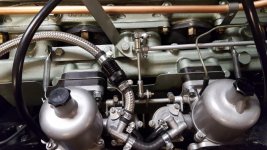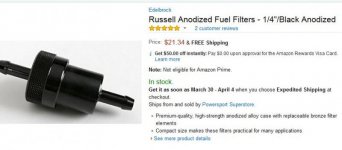Hi Bob,
I am glad you are open to the concept.
Take a look at Dave's document and you will see how the SU pumps will overheat and burn out if fuel is blocked. It is not the temperature of the gas but stopping the operation of the pump that causes the unit to overheat. The pump must be allowed to pump and a blocked input filter would cause it to stop with power on.
https://userwebs.donobi.net/sufuelpumps/Fuel_Pumps/SU_Fuel_Pumps_Facts_and_Myths.pdf
Enjoy,
Ray(64BJ8P1)
Ray,
Right you are, the pump will 'stall' on the intake cycle and overheat/burn resistor if the inlet side is blocked. For some reason--you didn't specify--I thought you were referring to blockage on the outlet side--where Dave 'recommends' (sort of) to put the filter--which is not a problem. On the output cycle as the points (or SS circuit) will be open and current will not be flowing (the pump will slowly bleed down, allowing plenty of time for the solenoid to cool).
I don't think Dave is a fan of filters in general, esp. as a 'bandaid:'
"The bottom line here is that if you are having a sediment and/or rust problem with the fuel tank that is severe enough to require a filter, then the tank should be removed, cleaned and sealed, or a new tank installed." - DD
If you're sure the tank is clean, it's time to look at the lines.
I don't believe SU pumps are cooled by fuel; the only part that gets warm is the pump body/solenoid--which is insulated by by both a gasket and the diaphragm--from the pump head, which is the only part of the pump that contacts fuel. According to Dave's doc, pumps fail when blocked on the inlet causing current to flow continuously through the solenoid, which causes the internal resistor to fail (not from lack of cooling from fuel flow).
re: "I guess I have been lucky and depended, without issue, upon the original protection provided by the installed screens that are part of the SU pump and carburetors for protection in my Healey."
I agree. Almost 140K miles on my BJ8 without any problem with debris in fuel.

 Hi Guest!
Hi Guest!

 smilie in place of the real @
smilie in place of the real @
 Pretty Please - add it to our Events forum(s) and add to the calendar! >>
Pretty Please - add it to our Events forum(s) and add to the calendar! >> 




